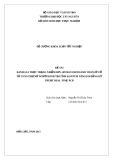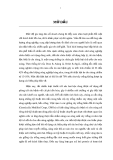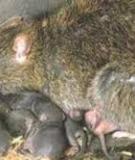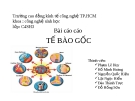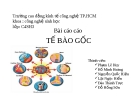R E S E A R C H
Open Access
Liu et al. Algorithms for Molecular Biology 2010, 5:30 http://www.almob.org/content/5/1/30
Survival associated pathway identification with group Lp penalized global AUC maximization
Zhenqiu Liu1,2*, Laurence S Magder2, Terry Hyslop3, Li Mao4
Abstract It has been demonstrated that genes in a cell do not act independently. They interact with one another to com- plete certain biological processes or to implement certain molecular functions. How to incorporate biological path- ways or functional groups into the model and identify survival associated gene pathways is still a challenging problem. In this paper, we propose a novel iterative gradient based method for survival analysis with group Lp penalized global AUC summary maximization. Unlike LASSO, Lp (p < 1) (with its special implementation entitled adaptive LASSO) is asymptotic unbiased and has oracle properties [1]. We first extend Lp for individual gene identi- fication to group Lp penalty for pathway selection, and then develop a novel iterative gradient algorithm for pena- lized global AUC summary maximization (IGGAUCS). This method incorporates the genetic pathways into global AUC summary maximization and identifies survival associated pathways instead of individual genes. The tuning parameters are determined using 10-fold cross validation with training data only. The prediction performance is evaluated using test data. We apply the proposed method to survival outcome analysis with gene expression pro- file and identify multiple pathways simultaneously. Experimental results with simulation and gene expression data demonstrate that the proposed procedures can be used for identifying important biological pathways that are related to survival phenotype and for building a parsimonious model for predicting the survival times.
Background Biologically complex diseases such as cancer are caused by mutations in biological pathways or functional groups instead of individual genes. Statistically, genes sharing the same pathway have high correlations and form functional groups or biological pathways. Many databases about biological knowledge or pathway infor- mation are available in the public domain after many years of intensive biomedical research. Such databases are often named metadata, which means data about data. Examples of such databases include the gene ontology (GO) databases (Gene Ontology Consortium, 2001), the Kyoto Encyclopedia of Genes and Genomes (KEGG) database [2], and several other pathways on the internet (e.g., http://www.superarray.com; http://www. biocarta.com). Most current methods, however, are developed purely from computational points without utilizing any prior biological knowledge or information. Gene selections with survival outcome data in the
statistical literature are mainly within the penalized Cox or additive risk regression framework [3-8]. The L1 and Lp (p < 1) penalized Cox regressions can work for simultaneous individual gene selection and survival pre- diction and have been extensively studied in statistics and bioinformatics literature [8-11]. The performance of the survival model is evaluated by the global area under the ROC curve summary (GAUCS) [12]. Unfortunately, those methods are mainly for individual gene selections and cannot be used to identify pathways directly. In microarray analysis, several popular tools for pathway analysis, including GENMAP, CHIPINFO, and GOMI- NER, are used to identify pathways that are over- expressed by differentially expressed genes. These gene set enrichment analysis (GSEA)methods are very infor- mative and are potentially useful for identifying path- ways that related to disease status [13]. One drawback with GSEA is that it considers each pathway separately and the pathway information is not utilized in the mod- eling stage. Wei and Li [14] proposed a boosting algo- rithm incorporating related pathway information for classification and regression. However, their method can only be applied for binary phenotypes. Since most
* Correspondence: zliu@umm.edu 1Greenebaum Cancer Center, University of Maryland, 22 South Greene Street, Baltimore, MD 21201, USA Full list of author information is available at the end of the article
© 2010 Liu et al; licensee BioMed Central Ltd. This is an Open Access article distributed under the terms of the Creative Commons Attribution License (http://creativecommons.org/licenses/by/2.0), which permits unrestricted use, distribution, and reproduction in any medium, provided the original work is properly cited.
n , } i i
complex diseases such as cancer are believed to be asso- ciated with the activities of multiple pathways, new sta- tistical methods are required to select multiple pathways simultaneously with the time-to-event phenotypes.
the
i
i
) ≤
=
= * Pr | M c dN t ( ) ( i i ≤ t M c t Pr ( ) |
i
i
i
1
( )
) = ∫
Group Lp Penalized GAUCS Maximization
Consider we have a set of n independent observations
=1 , where δi is the censoring indicator and
x
{ ,
t i
i
is the survival time (event time) if δ i = 1 or
t i
censoring time if δi = 0, and xi is the m-dimensional
ith sample. We denote
vector of
input
( ) =
*
≤1
N ti
and the corresponding increment
t
t
)
(
i
− . The time-dependent sensi-
−
=
*
*
*
(
N t N t
( )
( )
dN t
)
i
i
i
tivity and specificity are defined by sensitivity (c, t):
= 1 and specifi-
>
=
>
t
)
Pr
M c t
|
(
= 0 .
>
*
city (c, t): (
M c N t
|
Pr
)
( )
(
i
Here sensitivity measures the expected fraction of
subjects with a marker greater than c among the sub-
population of individuals who die (cases) at time t,
while specificity measures the fraction of subjects
with a marker less than or equal to c among those
who survive (controls) beyond time t. With this defi-
nition, a subject can play the role of a control for an
early time, t 0 where TPt and FPt are the true and false positive rate
at time t respectively, and [FPt]-1(q) = infc{c : FPt(c) ≤ q}.
ROC methods can be used to characterize the ability of a
marker to distinguish cases at time t from controls at time
t. However, in many applications there is no prior time t
identified and thus a global accuracy summary is defined
by averaging over t: GAUCS AUC t g t S t dt (1) =
= ( ) ( ) ( )
>
< ∫2
Pr
( |
M M t t ), k j j k which indicates the probability that the subject who
died (cases) at the early time has a larger value of the
marker, where S(t) and g(t) are the survival and corre-
sponding density functions, respectively. m mr m
1 = × Assuming there are r clusters in the input covariates,
our primary aim is to identify a small number of clus-
ters associated with survival time ti. Mathematically, for
each input xi (cid:1) Rm, we are given a decomposition of Rm
as a product of r clusters:
×
m ,+ T r ∈ m
1 = ( Page 2 of 13 Liu et al. Algorithms for Molecular Biology 2010, 5:30
http://www.almob.org/content/5/1/30 ) , , 2 r A ROC curve provides complete information on the
set of all possible combinations of true-positive and
false-positive rates, but is also more generally useful as a
graphic characterization of the magnitude of separation
between the case and control distributions. AUC is
known to measure the probability that the marker value
(score) for a randomly selected case exceeds the marker
value for a randomly selected control and is directly
related to the Mann-Whitney U statistic [15,16]. In sur-
vival analysis, a survival time can be viewed as a time-
varying binary outcome. Given a fixed time t, the
instances for which ti = t are regarded as cases and sam-
ples with ti >t are controls. The global AUC summary
(GAUCS) is then defined as GAUCS = P (Mj >Mk|tj
n = − − λ L2 norm. Since w is defined by clusters, we define a
weighted group Lp norm Page 3 of 13 Liu et al. Algorithms for Molecular Biology 2010, 5:30
http://www.almob.org/content/5/1/30 E
log ( )) L p k p j N = k 2 r <
j k
=
1
j (5) = n r L d | p l p
| ,w
l = − − λ d |
log ( )) l =
1 j k l p
| ,w
l 1
N == k 2 =
1 l <
j k
=
1
j =
| ( 1 2
)/
) l l = < max GAUCS max >
Pr M M t
| t ) k j k (2) (
< s t
. . j
, L p where l is a penalized parameter controlling model
complexity. Equation (5) is the maximum a posterior
(MAP) estimator of w with Laplace prior provided we
treat the sigmoid function as the pair-wise probability,
i.e. Pr(Mj > Mk) = s(wT (xj - xk)). When p = 1, Ep is a
convex function. A global optimal
solution is
guaranteed. where Mj = wT xj . The ideal situation is that M(xj) >
M(xk ) or wT (xj - xk) > 0, ∀ couple (xj, xk) with corre-
sponding times tj = > < GAUCS t ) j M t
|
k j k >
M j Mk n
=∑
k 2 Pr M
(
<
j k
∑
=
(3) j = , 1 n
=∑
k 2 1
<
j k
∑
=
1 j The IGGAUCS Algorithm
In order to find the w that maximizes Ep, we need to
find the first order derivative. Since group Lp with p ≤ 1
is not differentiable at |wl| = 0, differentiable approxi-
mations of group Lp is required. We propose a local
quadratic approximation for group |wl|p based on con-
vex duality and local variational methods [23,24]. Fan
and Li [25] proposed a similar approximation for single
variable. The adaptive LASSO approach proposed by
Zou and Li [21] is a LASSO (linear bound) approxima-
tion for Lp penalty. The drawback with that approach is
that LASSO itself is not differentiable at |wl| = 0. Since
|wl|p is concave when p < 1, we can have = = − f ( ) | 2
| )} l l
l l
(
g
l p
| min{ |
l (6) = − 2
| f ))},
(
g
l
l
l
(
l ) min{ |
|
|
l = where 1a>b = 1 if a >b, and 0 otherwise. Obviously,
GAUCS is a measure to rank the patients’ survival time.
The perfect GAUCS = 1 indicates that the order of all
patients’ survival time are predicted correctly and
GAUCS = 0.5 indicates for a completely random choice.
One way to approximate step function 1M Mj
is
k>
and let 1 1
+ −
e z = to use a sigmoid function ( )z
1
N ∑∑ = , then n
k 2 <
j k
=
1
j − (
( )) j k n
=∑
k 2 (4) <
j k
∑
=
1 j = . GAUCS N f
l where the function g(.) is the dual function of f(.) in
variational analysis. Geometrically, g(hl) represents the
amounts of vertical shift applied to hl|wl|2 to obtain a
quadratic upper bound with precision parameter hl, that
touches f(wl). Taking the first order derivative for
2 − ( ) , the minimum occurs at a solution of sta-
l
l
tionary equation when θl ≠ 0, = ⇒ = − ′
f | 0 ,
|
2
l
l
( )
l
l ′
(
)
f
l
|
|
2
l Equation (4) is nonconvex function and can only be
solved with the conjugate gradient method to find a
local minimum. Based on the property that the arith-
metic average is greater than the geometric average, we
have and f ′(θl) = p|θl|p-1. Substituting into f(wl), we have the variational bound: − (
( )) j k n n
=∑
k 2 <
j k
∑
=
1 j ≥ − ) f
( )). j k ∏∏ ≤ − + ( | f p
|
l 2
|
l 2
| )
|
l
( )
l N 1
N = k 2 ′
(
l
2
l <
j k
=
1
j (7) − 2 = − p
| | { |
p ) |
p +
(
2 p| } , l
l 2
|
l We can, therefore, maximize the following log likeli- 1
2 hood lower bound of equation (4). where θl denote variational parameters. With the local
quadratic bound, we have the following smooth lower
bound. r n = − − Page 4 of 13 Liu et al. Algorithms for Molecular Biology 2010, 5:30
http://www.almob.org/content/5/1/30 E
log ( )) d | p
| p k l l j 1
N = =
1 l 2 k <
j k
=
1
j n ≥ −
log ( )) k j (8) 1
N = 2 k <
j k
=
1
j r − − − p
| 2
| 2
| p
) | p
| } +
(
2 l
l
l dl p
{ |
2 = =
1
l
, ).w
EE( Choice of Parameters
There are two parameters p and l in this method,
which can be determined through 10-fold cross valida-
tion. One efficient way is to set p = 0.1, 0.2,..., and 1
respectively, and search for an optimal l for each p
using cross validation. The best (p, l) pair will be found
with the maximal test GAUCS value. Theoretically when
p = 1, E(w, θ) is convex and we can find the global max-
imum easily, but the solution is biased and small values
of p would lead to better asymptotic unbiased solutions.
Our results with limited experiments show that optimal
p usually happens at a small p such as p = 0.1. For com-
parison purposes, we implement the popular Cox
regression with group LASSO (GL1Cox), since there is
no software available in the literature. Our implementa-
tion is based on group LASSO penalized partial log-like-
lihood maximization. The best l is searched from l (cid:1)
[0.1, 25] for IGGAUCS and from l (cid:1) [0.1, 40] for
GL1Cox method with the step size of 0.1, as the Lp pen-
alty goes to zero much quicker than L1. We suggest that
the larger step size such as 0.5 can be used for most
applications, since the test GAUCS does not change dra-
matically with a small change of l. = In equation (8), the lower bound E(w, θ) is differenti-
able w.r.t both w and θ. We therefore propose a EM
algorithm to maximize E(w, θ) w.r.t w while keeping θ
fixed and maximize E(w, θ) w.r.t the variational para-
meter θ to tighten the variational bound while keeping
w fixed. Convergence to the local optimum is guaran-
teed. Since maximization w.r.t the variational parameters
0 = (|θ1|,|θ2|,..., |θr|), with w being fixed, can be solved
0 we have θl =
with the stationary equation
wl, for l = 1, 2,..., r. = ∂ Given r candidate pathways potentially associated with
the survival time, ml survival associated genes with the
expression of xl on each pathway l (l = 1, 2,..., r), and
letting w = (w1, w2,..., wr)T be a vector of the corre-
, we have
sponding coefficients and g
the following iterative gradient algorithm for E(w, θ)
maximization: T The IGGAUCS Algorithm
Given p, l, and (cid:1) = 10-6, initializing w1 , ) 1
2 l ,
1 r , 1
randomly with nonzero w l ,
Update w with θ fixed: − t t [ (
g )] ) ) = wt+1 = wt + atdt, where t: the number of iterations
and at: the step size, dt is updated with the conju-
gate gradient method:
dt = g(wt) + utdt and u t . −
t T g
(
−
1
t ) ( ) g ( Update θ with w fixed: θt+1 = wt+1 Stop when |wt+1 - wt| < (cid:1) or maximal number of Computational Results
Simulation Data
We first perform simulation studies to evaluate how
well the IGGAUCS procedure performs when input data
has a block structure. We focus on whether the impor-
tant variable groups that are associated with survival
outcomes can be selected using the IGGAUCS proce-
dure and how well the model can be used for predicting
the survival time for future patients. In our simulation
studies, we simulate a data set with a sample size of 100
and 300 input variables with 100 groups (clusters). The
triple variables x1 - x3, x4 - x6, x7 - x9,..., x298 - x300
within each group are highly correlated with a common
correlation g and there are no correlations between
groups. We set g = 0.1 for weak correlation, g = 0.5 for
moderate, and g = 0.9 for strong correlation in each tri-
ple group and generate training and test data sets of
sample size 100 with each g respectively from a normal
distribution with the band correlation structure. We
assume that the first three groups(9 covariates) (x1 - x3,
x4 - x6, x7 - x9) are associated with survival and the 9
covariates are set to be w = [-2.9 2.1 2.4 1.6 -1.8 1.4 0.4
0.8 -0.5]t. With this setting, 3 covariates in the first
group have the strongest association (largest covariate
values) with survival time and 3 covariates in group 3
have less association with survival time. The survival
time is generated with H = 100 exp(-wT x + ε) and the
Weibull distribution, and the census time is generated iterations exceeded. from 0.8*median(time) plus a random noise. Based on
this setting, we would expect about 25% - 35% censor-
ing. To compare the performance of IGGAUCS and
GL1Cox, we build the model based on training data set
and evaluate the model with the test data set. We repeat
this procedure 100 times and use the time-independent
GAUCS to assess the predictive performance. We first compare the performance of IGGAUCS and
GL1Cox methods with the frequency of each of these
three groups being selected under two different correla-
tion structures based on 100 replications. The results
are in Table 1. Table 1 shows that IGGAUCS with p =
0.1 outperforms the GL1Cox in that IGGAUCS can
identify the true group structures more frequently under
different inner group correlation structures. Its perfor-
mance is much better than GL1Cox regression, when
the inner correlation in a group is high (g = 0.9) and the
variables within a group have weak association with sur-
vival time. To compare more about Table 2 shows that IGGAUCS performs better than
GL1Cox regression. This is reasonable, since our
method, unlike Cox regression which maximizes a par-
tial log likelihood, directly maximizes the penalized
GAUCS. One interesting result is that the test GAUCSs
become smaller as the inner group correlation coeffi-
cient g increases from 0.1 to 0.9. We also apply the gene
harvesting method proposed by Hastie et al. (2001) and
discussed by Segal (2006) [7,26] to the simulation data,
but don’t show the results in Table 2. The gene harvest
method uses the average gene expression in each group
(cluster) and ignore the variance among genes within
the group. The prediction performances are poor with
test GAUCS of 0.57 ± 0.02 and 0.65 ± 0.016 respec-
tively, when the correlations among genes are weak (g =
0.1) and moderate (g = 0.5). Its performance is slightly
better with the test GAUCS of 0.75 ± 0.024, when g =
0.9, but this4 performance is still not as good as either
IGGAUCS or GL1Cox. One explantation is that the
group is more heterogeneous with weaker correlations
among variables, and the average does not provide a
meaningful summary. Moreover, we cannot identify the
survival association of individual variables using gene
harvesting.
Follicular Lymphoma (FL) Data
Follicular lymphoma is a common type of Non-Hodgkin
Lymphoma (NHL). It is a slow growing lymphoma that
arises from B-cells, a type of white blood cell. It is also
called an “indolent” or “low-grad” lymphoma for its
slow nature, both in terms of its behavior and how it
looks under the microscope. A study was conducted to
predict the survival probability of patients with gene
expression profiles of tumors at diagnosis [27]. the performance of
IGGAUCS and GL1Cox in parameter estimation, we
show the results for each parameter with different inner
correlation structures (0.1, 0.5, 0.9) in Figure 1. For each
parameter in Figure 1, the left bar represents the para-
meter estimated from GL1Cox, the middle bar is the
true value of the parameter, and the right bar indicates
parameter estimated from IGGAUCS. We observe that
both the GL1Cox and IGGAUCS methods estimated the
sign of the parameters correctly for the first two groups.
However both methods can only estimate the sign of w8
correctly in group 3 with smaller coefficients. Moreover,
ŵ estimated from IGGAUCS is much closer to the true
w than that from GL1Cox, especially when the covari-
ates are larger. This indicates that the Lp (p = 0.1) pen-
alty is less biased than the L1 penalty. The estimators of
IGGAUCS are larger than that of GL1Cox with weak,
moderate, and strong correlations. Finally, the test glo-
bal AUC summaries (GAUCSs) of IGGAUCS and
GL1Cox with 100 replications are shown in Table 2. Table 1 Frequency of Three Survival Associated Groups
Selected in 100 Replications Page 5 of 13 Liu et al. Algorithms for Molecular Biology 2010, 5:30
http://www.almob.org/content/5/1/30 Parameters IGGAUCS/GL1Cox
g = 0.1 g = 0.5 g = 0.9 100/100 100/100 100/100 w1 = -2.9
w2 = 2.1
w3 = 2.4 100/78 100/84 100/96 w4 = 1.6
w5 = -1.8
w6 = 1.4 Fresh-frozen tumor biopsy specimens and clinical data
were obtained from 191 untreated patients who had
received a diagnosis of follicular lymphoma between
1974 and 2001. The median age of patients at diagnosis
was 51 years (range 23 - 81) and the median follow up
time was 6.6 years (range less than 1.0 - 28.2). The med-
ian follow up time among patients alive was 8.1 years.
Four records with missing survival information were
excluded from the analysis. Affymetrix U133A and
U133B microarray gene chips were used to measure
gene expression levels from RNA samples. A log 2
transformation was applied to the Affymetrix measure-
ment. Detailed experimental protocol can be found in
Dave et al. 2004. The data set was normalized for each
gene to have mean 0 and variance 1. Because the data is
very large and there are many genes with their expres-
sions that either do not change cross samples or change
randomly, we filter out the genes by defining a correla-
tion measure with GAUCS for each gene xi R(t, xi) =
|2GAUCS(t, xi) - 1|, where R = 1 when GAUCS = 0, or
1 and R = 0 when GAUCS = 0.5 (gene xi
is not 47/2 53/4 94/24 w7 = 0.4
w8 = 0.8
w9 = -0.5 2 0 r = 0.1 −2 GL1Cox True Values IGAUCS 2 0 r = 0.5 −2 2 0 r = 0.9 −2 w1 w2 w3 w4 w5 w6 w7 w8 w9 Page 6 of 13 Liu et al. Algorithms for Molecular Biology 2010, 5:30
http://www.almob.org/content/5/1/30 phenotypes. We first randomly divide the data into two
subsets, one for training with 137 samples, and the
other for testing with 50 samples. To avoid overfitting
and bias from a particular partition, we randomly parti-
tion the data 50 times to estimate the performance of
the model with the average of the test GAUCS. The reg-
ularization parameter l is tuned using 10-fold cross-
validation with training data only. associated with the survival time). We perform the per-
mutation test 1000 times for R to identify 2150 probes
associated with survival time. We then identify 49 candi-
date pathways with 5 and more genes using DAVID.
There are total 523 genes on the candidate pathways.
Since a gene can be involved in more than one pathway,
the number of distinguished genes should be a little less
than 500. The 49 biological pathways are given in Table
3. We finally apply IGGAUCS to identify the small
number of biological pathways associated with survival Table 2 Test GAUCS of Simulated Data with Different
Correlation Structures Figure 1 True and Estimated Parameters. The true and estimated parameters with the simulation data are shown in Figure 2. The left bars
represent each parameter estimated from GL1Cox, the middle bars are the true value of the parameter, and the right bars indicate parameters
estimated form IGGAUCS. Since it is possible different pathways may be selected
in the cross validation procedure, the relevance count
concept [28] was utilized to count how many times a
pathway is selected in the cross validation. Clearly, the
maximum relevance count for a pathway is 200 with the
10-fold cross validation and 20 repeating. We have
selected 8 survival associated pathways with IGGAUCS.
The average test GAUCS is 0.892 ± 0.013. Moreover,
the parameters (weights) wi and corresponding genes on
each pathway indicate the association strength and Correlation IGGAUCS 0.921(±0.023) GL1Cox
0.897(±0.031) 0.889(±0.021) 0.871(±0.024) 0.866(±0.017) 0.828(±0.025) g = 0.1
g = 0.5
g = 0.9 Table 3 Candidate Survival Associated Pathways Page 7 of 13 Liu et al. Algorithms for Molecular Biology 2010, 5:30
http://www.almob.org/content/5/1/30 # of Genes # of Genes Pathways Pathways Propanoate metabolism 5 Melanoma 10 Type II diabetes mellitus 6 Thyroid cancer 5 Adipocytokine signaling pathway 10 Prostate cancer 13 Melanogenesis 13 Glycolysis/Gluconeogenesis 8 GnRH signaling pathway 11 Butanoate metabolism 6 Insulin signaling pathway 15 Endometrial cancer 11 Sphingolipid metabolism 5 Pancreatic cancer 10 Glycerophospholipid metabolism
T cell receptor signaling pathway 9
11 12
6 Hematopoietic cell lineage 10 5 Glycerolipid metabolism 6 Colorectal cancer
RNA polymerase
Huntington’s disease
Focal adhesion 20 Toll-like receptor signaling pathway 13 Apoptosis 12 Antigen processing and presentation 9 Adherens junction 10 Complement and coagulation cascades 8 Tryptophan metabolism 7 ECM-receptor interaction 14 Histidine metabolism 6 external signals, leading to a wide range of cellular
responses, including growth, differentiation, inflamma-
tion, and apoptosis invasiveness and ability to induce
neovascularization. MAPK signaling pathway has been
linked to different cancers including follicular lymphoma
[29]. The pathway and genes on pathways are given in
Figure 2. direction between genes and the survival time. Positive
wis indicate that patients with high expression level die
earlier and negative wis represent that patients live
longer with relatively high expression levels. The abso-
lute values of |wi| indicate the strength of association
between survival time and the specific gene. Genes on
the pathway, estimated parameters, and relevance
accounts are given in Table 4. Genes in red color are highly expressed in patients
with aggressive FL and genes in yellow are highly
expressed in the earlier stage of FL cancers. Many
important cancer related genes are identified with our
methods. For example, SOS1, one of the RAS genes (e.
g., MIM 190020), encodes membrane-bound guanine
nucleotide-binding proteins that function in the trans-
duction of signals that control cell growth and differen-
tiation. Binding of GTP activates RAS proteins, and
subsequent hydrolysis of the bound GTP to GDP and
phosphate inactivates signaling by these proteins. GTP
binding can be catalyzed by guanine nucleotide
exchange factors for RAS, and GTP hydrolysis can be
accelerated by GTPase-activating proteins (GAPs). SOS1
plays a crucial role in the coupling of RTKs and also
intracellular tyrosine kinases to RAS activation. The
deregulation of receptor tyrosine kinases (RTKs) or
intracellular tyrosine kinases coupled to RAS activation The eight KEGG pathways identified play an impor-
tant role in patient survivals and they can be ranked
with the average |wj |:∑j |wj |/L, where L is the number
of genes on a pathway as shown in Table 5. The identi-
fied 8 KEGG pathways fall into three categories (i) sig-
naling molecules and interaction including the MAPK
signaling pathway, the Calcium signaling pathway, Focal
adhesion, ECM-receptor interactions and neuroactive
ligand-receptor interactions, (ii) metabolic pathways
including Fatty acid metabolism and Porphyrin and
chlorophyll metabolism, and (iii) nitric oxide and cell
stress including Ubiquitin mediated proteolysis. These
pathways are involved in different aspects of genetic
functions and are vital for cancer patient survivals. We
only discuss the MAPK signaling pathway but others
can be analyzed in a similar fashion. The top-rank
MAPK signaling pathway transduces a large variety of Wnt signaling pathway
Ubiquitin mediated proteolysis 20
15 Fatty acid metabolism
Acute myeloid leukemia 10
9 Neuroactive ligand-receptor interaction 28 Bladder cancer 6 gamma-Hexachlorocyclohexane degradation 5 Focal adhesion 20 Calcium signaling pathway 21 ErbB signaling pathway 11 MAPK signaling pathway 31 PPAR signaling pathway 16 Valine, leucine and isoleucine degradation 6 Glioma 7 Pyrimidine metabolism 12 Chronic myeloid leukemia 10 Non-small cell lung cancer 11 Glycan structures - degradation
Porphyrin and chlorophyll metabolism 5
7 Table 4 Genes on pathway, relevance accounts, and estimated parameters
wi Page 8 of 13 Liu et al. Algorithms for Molecular Biology 2010, 5:30
http://www.almob.org/content/5/1/30 Gene Name GeneID ECM-receptor interaction (relevance counts: 200) 0.2239 CD36 cd36 antigen (collagen type i receptor, thrombospondin receptor) 0.0409 FNDC1 fibronectin type iii domain containing 1 0.0746 SV2C synaptic vesicle glycoprotein 2c 0.0804 SDC1 syndecan 1 -0.1255 FN1 fibronectin 1 0.0211 LAMC1 laminin, gamma 1 (formerly lamb2) -0.0854
-0.1130 GP5
CD47 glycoprotein v (platelet)
cd47 antigen (rh-related antigen, integrin-associated signal transducer) -0.1296 THBS2 thrombospondin 2 -0.0547 COL1A2 collagen, type i, alpha 2 -0.1024 COL5A2 collagen, type v, alpha 2 0.0861 LAMB4 laminin, beta 4 -0.0315 COL1A1 collagen, type i, alpha 1 0.0395 AGRN agrin RG Focal adhesion (relevance counts 145) 0.0054 PAK3 p21 (cdkn1a)-activated kinase 3 0.0446 PIK3R3 phosphoinositide-3-kinase, regulatory subunit 3 (p55, gamma) 0.0044 PDPK1 3-phosphoinositide dependent protein kinase-1 -0.0045 BAD bcl2-antagonist of cell death 0.0087 PARVA parvin, alpha -0.0144 FN1 fibronectin 1 0.0041 LAMC1 laminin, gamma 1 (formerly lamb2) -0.0202
-0.0158 PARVG
THBS2 parvin, gamma
thrombospondin 2 0.0134 PPP1R12A protein phosphatase 1, regulatory (inhibitor) subunit 12a -0.0044 SOS1 son of sevenless homolog 1 (drosophila) -0.0084 COL1A2 collagen, type i, alpha 2 -0.0122 COL5A2 collagen, type v, alpha 2 0.0091 LAMB4 laminin, beta 4 RG Homo sapiens -0.0068 RAF1 v-raf-1 murine leukemia viral oncogene homolog 1 -0.0038
-0.0034 ACTN1
COL1A1 actinin, alpha 1
collagen, type i, alpha 1 -0.0067 GSK3B glycogen synthase kinase 3 beta -0.0065 MAPK8 mitogen-activated protein kinase 8 -0.0030 MYL7 myosin, light polypeptide 7, regulatory Neuroactive ligand-receptor interaction (relevance counts: 200) 0.0894 P2RY6 pyrimidinergic receptor p2y, g-protein coupled, 6 -0.2753
0.1648 PTAFR
GLRA3 platelet-activating factor receptor
glycine receptor, alpha 3 0.0857 FPRL1 formyl peptide receptor-like 1 -0.1783 EDNRA endothelin receptor type a 0.3233 HRH4 histamine receptor h4 0.2106 GRM2 glutamate receptor, metabotropic 2 -0.1112 GRIN1 glutamate receptor, ionotropic, n-methyl d-aspartate 1 -0.0220 PTHR1 parathyroid hormone receptor 1 0.0971
-0.4303 OPRM1
CTSG opioid receptor, mu 1
cathepsin g -0.0404 P2RY8 purinergic receptor p2y, g-protein coupled, 8 -0.0783 BDKRB1 bradykinin receptor b1 0.3247 FSHR follicle stimulating hormone receptor Table 4 Genes on pathway, relevance accounts, and estimated parameters (Continued) Page 9 of 13 Liu et al. Algorithms for Molecular Biology 2010, 5:30
http://www.almob.org/content/5/1/30 -0.1430 ADRA1B adrenergic, alpha-1b-, receptor 0.1464 C3AR1 complement component 3a receptor 1 0.1120 P2RX2 purinergic receptor p2x, ligand-gated ion channel, 2 0.0311
0.2646 AVPR1B
FPR1 arginine vasopressin receptor 1b
formyl peptide receptor 1 0.2003 GABRA5 gamma-aminobutyric acid (gaba) a receptor, alpha 5 -0.0278 PRLR prolactin receptor -0.1070 ADORA1 adenosine a1 receptor 0.2652 HTR7 5-hydroxytryptamine (serotonin) receptor 7 (adenylate cyclase-coupled) -0.0194 GABRA4 gamma-aminobutyric acid (gaba) a receptor, alpha 4 0.0145 GHRHR growth hormone releasing hormone receptor -0.3163
-0.0760 MAS1
PTGER3 mas1 oncogene
prostaglandin e receptor 3 (subtype ep3) 0.2196 PARD3 par-3 partitioning defective 3 homolog (c. elegans) Ubiquitin mediated proteolysis (relevance counts: 200) 0.0186 UBE2B ubiquitin-conjugating enzyme e2b (rad6 homolog) -0.0677 CUL4A cullin 4a 0.0051 PML promyelocytic leukemia -0.1023 UBE3B ubiquitin protein ligase e3b -0.1581
0.1390 UBE3C
BTRC ubiquitin protein ligase e3c
beta-transducin repeat containing -0.0669 HERC3 hect domain and rld 3 0.00009 RBX1 ring-box 1 0.0011 CUL5 cullin 5 0.0267 ANAPC4 anaphase promoting complex subunit 4 -0.0253 UBE2L3 ubiquitin-conjugating enzyme e2l 3 0.0096 KEAP1 kelch-like ech-associated protein 1 -0.0267
0.0116 UBE2E1
CBL ubiquitin-conjugating enzyme e2e 1 (ubc4/5 homolog, yeast)
cas-br-m (murine) ecotropic retroviral transforming sequence 0.0328 BIRC6 baculoviral iap repeat-containing 6 (apollon) Porphyrin and chlorophyll metabolism (relevance counts: 185) 0.0330 BLVRA biliverdin reductase a -0.0103 FTH1 ferritin, heavy polypeptide 1 0.0227 ALAD aminolevulinate, delta-, dehydratase 0.1983
0.0070 HMOX1
UROS heme oxygenase (decycling) 1
uroporphyrinogen iii synthase (congenital erythropoietic porphyria) -0.1596 GUSB glucuronidase, beta 0.0077 UGT2B15 udp glucuronosyltransferase 2 family, polypeptide b15 Calcium signaling pathway (relevance counts: 200) -0.0025 BST1 bone marrow stromal cell antigen 1 0.0003 BDKRB1 bradykinin receptor b1 -0.0016 PTAFR platelet-activating factor receptor -0.0002
-0.0007 ADRA1B
PPP3CC adrenergic, alpha-1b-, receptor
protein phosphatase 3 (formerly 2b), catalytic subunit, gamma isoform -0.0001 ADCY7 adenylate cyclase 7 0.0008 GNA11 guanine nucleotide binding protein (g protein), alpha 11 (gq class) -0.0013 AVPR1B arginine vasopressin receptor 1b 0.0014 P2RX2 purinergic receptor p2x, ligand-gated ion channel, 2 -0.0013 CACNA1E calcium channel, voltage-dependent, alpha 1e subunit 0.0004 EDNRA endothelin receptor type a 0.00009
0.0006 SLC8A1
CACNA1B solute carrier family 8 (sodium/calcium exchanger), member 1
calcium channel, voltage-dependent, l type, alpha 1b subunit Table 4 Genes on pathway, relevance accounts, and estimated parameters (Continued) Page 10 of 13 Liu et al. Algorithms for Molecular Biology 2010, 5:30
http://www.almob.org/content/5/1/30 PLCD1 phospholipase c, delta 1 -0.0013 HTR7 5-hydroxytryptamine (serotonin) receptor 7 (adenylate cyclase-coupled) -0.0029 GRIN1 glutamate receptor, ionotropic, n-methyl d-aspartate 1 0.0014 CAMK2A
CACNA1I calcium/calmodulin-dependent protein kinase (cam kinase) ii alpha
calcium channel, voltage-dependent, alpha 1i subunit 0.0028
-0.0024 TNNC1 troponin c type 1 (slow) -0.0002 PTGER3 prostaglandin e receptor 3 (subtype ep3) 0.0009 CACNA1F calcium channel, voltage-dependent, alpha 1f subunit 0.0012 Fatty acid metabolism (relevance counts: 192) ACSL3 acyl-coa synthetase long-chain family member 3 0.0043 ALDH2 aldehyde dehydrogenase 2 family (mitochondrial) 0.0675 ACAT2
ALDH1B1 acetyl-coenzyme a acetyltransferase 2 (acetoacetyl coenzyme a thiolase)
aldehyde dehydrogenase 1 family, member b1 -0.0491
0.0120 CYP4A11 cytochrome p450, family 4, subfamily a, polypeptide 11 0.0597 ACADSB acyl-coenzyme a dehydrogenase, short/branched chain -0.1447 CPT1A carnitine palmitoyltransferase 1a (liver) 0.0736 CPT1B carnitine palmitoyltransferase 1b (muscle) 0.1075 ACADVL acyl-coenzyme a dehydrogenase, very long chain -0.0366 ADH4 alcohol dehydrogenase 4 (class ii), pi polypeptide 0.2168 MAPK signaling pathway (relevance counts: 200) PLA2G10 phospholipase a2, group x -0.1570 MAPKAPK5 mitogen-activated protein kinase-activated protein kinase 5 -0.2415 IL1B interleukin 1, beta -0.1636 ZAK sterile alpha motif and leucine zipper containing kinase azk -0.0651 PPP3CC protein phosphatase 3 (formerly 2b), catalytic subunit, gamma isoform 0.0572 MAP3K2 mitogen-activated protein kinase kinase kinase 2 -0.0674 JUND
SOS1 jun d proto-oncogene
son of sevenless homolog 1 (drosophila) -0.1729
-0.1718 FGF14 fibroblast growth factor 14 0.1082 PTPN5 protein tyrosine phosphatase, non-receptor type 5 0.3102 CACNB1 calcium channel, voltage-dependent, beta 1 subunit -0.3903 MAP3K7 mitogen-activated protein kinase kinase kinase 7 0.2678 CACNG8 calcium channel, voltage-dependent, gamma subunit 8 0.3176 FGF19 fibroblast growth factor 19 0.0893 RRAS2
NLK related ras viral (r-ras) oncogene homolog 2
nemo-like kinase -0.0853
0.0215 MAP4K4 mitogen-activated protein kinase kinase kinase kinase 4 0.0452 CACNA1E calcium channel, voltage-dependent, alpha 1e subunit 0.1639 ARRB1 arrestin, beta 1 -0.0290 STK4 serine/threonine kinase 4 -0.1169 CACNA1B calcium channel, voltage-dependent, l type, alpha 1b subunit 0.1008 MOS v-mos moloney murine sarcoma viral oncogene homolog 0.0839 MEF2C
RAF1 mads box transcription enhancer factor 2, polypeptide c
v-raf-1 murine leukemia viral oncogene homolog 1 -0.1244
0.1572 MAPK8IP1 mitogen-activated protein kinase 8 interacting protein 1 0.1757 IKBKB inhibitor of kappa light polypeptide gene enhancer in b-cells, kinase beta 0.2908 CACNA1I calcium channel, voltage-dependent, alpha 1i subunit -0.3452 MAPK8 mitogen-activated protein kinase 8 -0.2473 CACNA1F calcium channel, voltage-dependent, alpha 1f subunit -0.2339 CD14 cd14 antigen 0.0979 MRAS muscle ras oncogene homolog -0.1047 Table 5 Pathway Ranks Page 11 of 13 Liu et al. Algorithms for Molecular Biology 2010, 5:30
http://www.almob.org/content/5/1/30 lymphocyte, fight infections. It also helps leukocytes
pass through blood vessel walls to sites of infection and
causes fever by affecting areas of the brain that control
body temperature. IL1B made in the laboratory is used
as a biological response modifier to boost the immune
system in cancer therapy. has been involved in the development of a number of
tumors, such as those in breast cancer, ovarian cancer
and leukemia. Another gene, IL1B, is one of a group of
related proteins made by leukocytes (white blood cells)
and other cells in the body. IL1B, one form of IL1, is
made mainly by one type of white blood cell, the macro-
phage, and helps another type of white blood cell, the As shown in Figure 2, the genes SOS1, IL1B, RAS,
CACNB1, MEF2C, JUND, and MAPKAPK5 are highly
expressed in patients who were diagnosed earlier and
lived longer and the genes FGF14, PTPN5, MOS,
RAF1, CD14 are highly expressed in patients who were
diagnosed at more aggressive stages and died earlier,
which may indicate that oncogenes such such SOS1,
JUND, and RAS may initialize FL cancer and genes
such as MOS, IKK, and CD14 may cause FL cancer to
be more aggressive. There are several causal relations
among the identified genes on MAPK. For instance,
the down-expressed SOS and RAS cause the up-
expressed RAF1 and MOS and the up-stream gene IL1 Pathway ∑j |wj|/L Rank MAPK signaling pathway 0.1614 1 Neuroactive ligand-receptor interaction 0.1562 2 ECM-receptor interaction 0.0863 3 Fatty acid metabolism 0.0772 4 Porphyrin and chlorophyll metabolism 0.0627 5 Ubiquitin mediated proteolysis 0.0494 6 Focal adhesion 0.0100 7 Calcium signaling pathway 0.0012 8 Figure 2 MAPK Signaling Pathway. MAPK signaling pathway and the associated genes. Genes in red are highly expressed in patients who
died earlier and genes in yellow are highly expressed in patients who lived longer. is coordinately expressed with CASP and the gene
MST1/2. Medicine, The University of Maryland, Baltimore, MD 21201, USA. 3Division of
Biostatistics, Department of Pharmacology and Experimental Therapeutics,
Thomas Jefferson University, Philadelphia, PA 19107, USA. 4Department of
Oncology and Diagnosis Sciences, The University of Maryland Dental School,
Baltimore, MD 21201, USA. Authors’ contributions
ZL designed the method and drafted the manuscript. Both LSM and TH
participated manuscript preparation and revised the manuscript critically. LM
provided important help in its biological contents. All authors read and
approved the final manuscript. Competing interests
The authors declare that they have no competing interests. Received: 7 January 2010 Accepted: 16 August 2010
Published: 16 August 2010 References
1. 2. 3. 4. 5. 6. Conclusions
Since a large amount of biological information on var-
ious aspects of systems and pathways is available in pub-
lic databases, we are able to utilize this information in
modeling genomic data and identifying pathways and
genes and their interactions that might be related to
patient survival. In this study, we have developed a
novel iterative gradient algorithm for group Lp penalized
global AUC summary (IGGAUCS) maximization meth-
ods for gene and pathway identification, and for survival
prediction with right censored survival data and high
dimensional gene expression profile. We have demon-
strated the applications of the proposed method with
both simulation and the FL cancer data set. Empirical
studies have shown the proposed approach is able to
identify a small number of pathways with nice predic-
tion performance. Unlike traditional statistical models,
the proposed method naturally incorporates biological
pathways information and it is also different from the
commonly used Gene Set Enrichment Analysis (GSEA)
in that it simultaneously considers multiple pathways
associated with survival phenotypes. 7. Zou H: The Adaptive Lasso and its Oracle Properties. Journal of the
American Statistical Association 2006, 101(476):1418-1429.
Kanehisa L, Goto S: KEGG: Kyoto encyclopedia of genes and genomes.
Nucleic Acids Research 2002, 28:27-30.
Tibshirani R: Regression shrinkage and selection via the lasso. J Royal
Statist Soc B 1996, 58(1):267-288.
Tibshirani R: The lasso method for variable selection in the Cox model.
Statistics in Medicine 1997, 16(4):385-95.
Gui J, Li H: Variable Selection via Non-concave Penalized Likelihood and
its Oracle Properties. Journal of the American Statistical Association, Theory
and Methods 2001, 96:456.
Van Houwelingen H, Bruinsma T, Hart A, Van’t Veer L, Wessels L: Cross-
validated Cox regression on microarray gene expression data. Stat Med
2006, 25:3201-3216.
Segal M: Microarray gene expression data with linked survival
phenotypes: diffuse large-B-cell lymphoma revisited. Biostatistics 2006,
7:268-285. 8. Ma S, Huang J: Additive risk survival model with microarray data. BMC 9. Bioinformatics 2007, 8:192.
Liu Z, Jiang F: Gene identification and survival prediction with Lp Cox
regression and novel similarity measure. Int J Data Min Bioinform 2009,
3(4):398-408. 10. Park M, Hastie T: L1 regularization path algorithm for generalized linear 11. With comprehensive knowledge of pathways and
mammalian biology, we can greatly reduce the hypoth-
esis space. By knowing the pathway and the genes that
belong to particular pathways, we can limit the number
of genes and gene-gene interactions that need to be
considered in modeling high dimensional microarray
data. The proposed method can efficiently handle thou-
sands of genes and hundreds of pathways as shown in
our analysis of the FL cancer data set. models. J R Stat Soc B 2007, 69:659-677.
Sohn I, Kim J, Jung S, Park C: Gradient Lasso for Cox Proportional Hazards
Model. Bioinformatics 2009, 25(14):1775-1781. 12. Heagerty P, Zheng Y: Survival model predictive accuracy and ROC curves. 13. Biometrics 2005, 61(1):92-105.
Tian L, Greenberg S, Kong S, Altschuler J, Kohane I, Park P: Discovering
statistically significant pathways in expression profiling studies. PNAS
2005, 103:13544-13549. 14. Wei Z, Li H: Nonparametric pathways-based regression models for analysis of genomic data. Biostatistics 2007, 8(2):265-284. 15. Pepe M: The Statistical Evaluation of Medical Tests for Classification and Prediction Oxford: Oxford University Press 2003. There are several directions for our future investiga-
tions. For instance, we may want to further investigate
the sensitivity of the proposed methods to the misspeci-
fication of the pathway information and misspecification
of the model. We may also extend our method to incor-
porate gene-gene interactions and gene (pathway)-
environmental interactions. 16. Pepe M: Evaluating technologies for classification and prediction in 17. Even though we have only applied our methods to
gene expression data, it is straightforward to extend our
methods to SNP, miRNA CGH, and other genomic data
without much modification. medicine. Stat Med 2005, 24(24):3687-3696.
Liu Z, Gartenhaus R, Chen X, Howell C, Tan M: Survival Prediction and
Gene Identification with Penalized Global AUC Maximization, Journal of
Computational Biology. Journal of Computational Biology 2009,
16(12):1661-1670. 18. Meier L, van de Geer S, Buhlmann P: The group lasso for logistic regression. Journal of the Royal Statistical Society: Series B (Statistical
Methodology) 2008, 70(1):53-71(19). 19. Bach F: Consistency of the Group Lasso and Multiple Kernel Learning. The Journal of Machine Learning Research 2008, 9:1179-1225. 20. Ma S, Song X, Huang J: Supervised group Lasso with applications to Acknowledgements
We thank the Associate Editor and the two anonymous referees for their
constructive comments which helped improve the manuscript. ZL was
partially supported by grant 1R03CA133899-01A210 from the National
Cancer Institute. microarray data analysis. BMC Bioinformatics 2007, 8:60. 21. Zou H, Li R: One-step sparse estimates in non-concave penalized likelihood models. The Annals of Statistics 2008, 36(4):1509-1533. Author details
1Greenebaum Cancer Center, University of Maryland, 22 South Greene Street,
Baltimore, MD 21201, USA. 2Department of Epidemiology and Preventive Page 12 of 13 Liu et al. Algorithms for Molecular Biology 2010, 5:30
http://www.almob.org/content/5/1/30 22. 23. 24. 25. Liu Z, Tan M: ROC-Based Utility Function Maximization for Feature
Selection and Classification with Applications to High-Dimensional
Protease Data. Biometrics 2008, 64(4):1155-1161.
Jordan M, Ghahramani Z, Jaakkola T, Saul L: An Introduction to Variational
Methods for Graphical models. Learning in Graphical Models Cambridge:
The MIT PressJordan M 1998.
Kaban A, Durrant R: Learning with Lq < 1 vs L1-norm regularization with
exponentially many irrelevant features. Proc of the 19th European
Conference on Machine Learning (ECML08) 2008, 15-19.
Fan J, Li R: Penalized Cox Regression Analysis in the High-Dimensional
and Low-sample Size Settings, with Applications to Microarray Gene
Expression Data. Bioinformatics 2005, 21:3001-3008. 26. Hastie T, Tibashirani DR, Botstein , Brown P: Supervised harvesting of expression trees. Genome Biology 2001, 2:3.1-3.12. 27. Dave S, Wright G, Tan B, Rosenwald A, Gascoyne R, Chan W, Fisher R, 28. 29. Braziel R, Rimsza L, Grogan T, Miller T, LeBlanc M, Greiner T,
Weisenburger D, Lynch J, Vose J, Armitage J, Smeland E, Kvaloy S, Holte H,
Delabie J, Connors J, Lansdorp P, Ouyang Q, Lister T, Davies A, Norton A,
Muller-Hermelink H, Ott G, Campo E, Montserrat E, Wilson W, Jaffe E,
Simon R, Yang L, Powell J, Zhao H, Goldschmidt N, Chiorazzi M, Staudt L:
Prediction of survival in follicular lymphoma based on molecular
features of tumor-infiltrating immune cells. N Engl J Med 2004,
351(21):2159-2169.
Liu Z, Jiang F, Tian G, Wang S, Sato F, Meltzer S, Tan M: Sparse logistic
regression with Lp penalty for biomarker identification. Statistical
Applications in Genetics and Molecular Biology 2007, 6(1):Article 6.
Elenitoba-Johnson K, Jenson S, Abbott R, Palais R, Bohling S, Lin Z, Tripp S,
Shami P, Wang L, Coupland R, Buckstein R, Perez-Ordonez B, Perkins S,
Dube I, Lim M: Involvement of multiple signaling pathways in follicular
lymphoma transformation: p38-mitogen-activated protein kinase as a
target for therapy. Proc Natl Acad Sci USA 2003, 100(12):7259-64. doi:10.1186/1748-7188-5-30
Cite this article as: Liu et al.: Survival associated pathway identification
with group Lp penalized global AUC maximization. Algorithms for
Molecular Biology 2010 5:30. Page 13 of 13 Liu et al. Algorithms for Molecular Biology 2010, 5:30
http://www.almob.org/content/5/1/30 Submit your manuscript at
www.biomedcentral.com/submitw
w w
,
1
, so that each data point xi can
be decomposed into r cluster components, i.e. xi =
(xi1,...,xir), where each xil is in general a vector. We
define M(x) = wT x to be the risk score function, where
+,
is the vector of
w
coefficients that has the same cluster decomposition as
xi. We denote Mi = M(xi) for simplicity. Our goal is to
encourage the sparsity of vector w at the level of clus-
ters; in particular, we want most of its multivariate com-
ponents wl to be zero. The natural way to achieve this is
to explore the combination of Lp (0 ≤ p ≤ 1) norm and
x
T
w x
(
∑∑1
∑
x
T
w x
(
∑∑
∑
T
w w
l
where within every group, an L2 norm is used
and dl can be set to be 1 if all clus-
w
(|
ters are equally important. Note that group Lp = L2 if
r = 1 and dl = 1, and group Lp = Lp when r = m and dl
= 1. We can define the optimization problem
1
w
w
w
T
w x
x
T
w x
x
T
w x
(
x
w
w
|
w
x
w
T
w x
(
∑
∑∑
x
T
w xx
(
∑∑
w
∑
∂
w
( , )
E
∂
|
|
l
w
( )
w w
E
( , )
∂
w
1
w w
,
1
= (
1
w r
,
= , and set θ1 = w1.
w
w
w
w
1
t
w
(
g
−
1
T g
Submit your next manuscript to BioMed Central
and take full advantage of:
• Convenient online submission
• Thorough peer review
• No space constraints or color figure charges
• Immediate publication on acceptance
• Inclusion in PubMed, CAS, Scopus and Google Scholar
• Research which is freely available for redistribution




